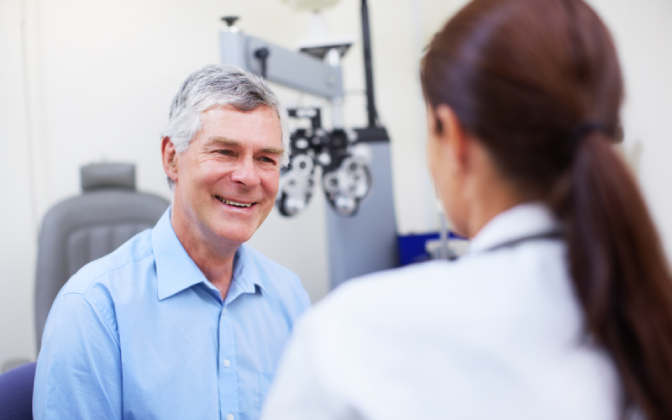Buy one pair of eyeglasses, get a second pair 50% off!
*Restrictions apply. Click here for details.

How to Read Your Contact Lens Prescription
You may notice that your contact prescription looks different than your prescription for glasses. If you're entirely new to receiving prescriptions and you're planning to correct your vision with contacts, the text on the slip of paper may look like a foreign language.
Knowing the abbreviations and numbers in your contact prescription is the first step in understanding how your contacts correct your vision. Once you know how to decipher the shorthand, you should be able to understand any contact lens prescription that comes your way.
Essential Abbreviations to Know
There are a few abbreviations you may see on your prescription:
OD: Right eye
OS: Left eye
SPH or PWR: Spherical correction or power
Numbers with plus or minus signs: Diopters, a number that measures corrective lens strength.
CYL: Cylindrical power
Axis: The direction a cylindrical lens needs to be tilted.
DS: Diopters sphere
ADD: Additional correction
Some of the abbreviations included in your contact lens prescription may be familiar, as they also appear in eyeglass prescriptions. The number listed with SPH or PWR is measured in diopters and describes the strength of the corrective lens. This number will be preceded by a plus sign (+) if you are farsighted and a minus sign (-) if you are nearsighted.
If you have astigmatism, a condition that occurs when the lens of the eye (the cornea) has an irregular shape, your prescription will include two additional abbreviations. One will be “CYL,” which determines how strong a cylindrical lens needs to be to correct your astigmatism. The other term will be “Axis,” which refers to the way the cylindrical lens needs to be tilted. If you don’t have astigmatism, your eye doctor may write “DS” to indicate that your eyes have a regular, spherical shape.
The final abbreviation you may encounter on your prescription is “ADD,” a short note that stands for “additional correction.” This may be added to your prescription to include details about bifocals, multifocal lenses, or progressive lenses.
What is the Difference Between a Contact Lens Prescription and an Eyeglasses Prescription?
Contact lens prescriptions contain extra abbreviations and numbers that don’t appear on eyeglass prescriptions. Luckily, our doctors are here to help make them easy to decipher. Here are some of the new abbreviations you might encounter on your contact lens prescription:
BC: Base curvature
DIA: Diameter
"BC" refers to the way that your cornea curves. It's necessary to include this detail because the shape of your contact lens needs to match the shape of your cornea to ensure a good fit.
Contact prescriptions also include the term "DIA," which describes the distance from one edge of the contact lens to the other. This is measured in millimeters. Additionally, your contact prescription will name the brand of contact lenses that your eye doctor prescribes, as well as an expiration date for the prescription.
If your eye doctor gives you both eyeglasses and contact prescriptions, you may notice some of the numbers listed alongside the corresponding abbreviations are different. This isn't a mistake; the prescriptions are different because people wear eyeglasses and contacts differently. Contacts sit on the surface of your eye, while eyeglasses sit a short distance away from your eye. Because you'll be looking through each lens from a slightly different distance, it's necessary to adjust the prescription accordingly. This ensures each type of corrective lens does its job from the appropriate distance.
How Your Eye Doctor Will Explain Your Prescription
When you receive a prescription for contacts, your eye doctor should explain why they're prescribing a certain type of contact. For example, you may have an astigmatism that needs to be corrected, or you may opt for multifocal lenses to help you see both near and far. Clarkson Eyecare provides several specialty contact lenses to help those with different eye conditions.
Your prescription will also include information about the contact lens brand that your eye doctor recommends. They may recommend a certain brand of contacts for many reasons, including the shape and curvature of your cornea, the complexity of your prescription, whether you have dry eyes, or other factors.
Your doctor will also want to discuss why you are choosing to wear contacts instead of, or in addition to, glasses. Together, based on your prescription and other factors, you should be able to find contacts that are comfortable, fit well, and help with vision correction.

Frequently Asked Questions About Contact Lens Prescriptions
Schedule a Contact Lens Fitting at Clarkson Eyecare
Wearing contact lenses and finding the right vision correction for your unique eyes doesn’t have to break the bank. At Clarkson Eyecare, we strive to provide affordable, high-quality eye care to every patient. With expansive insurance coverage options and dedicated staff, we ensure you find the best contact lenses for your specific needs.
If you're interested in wearing contacts, schedule an appointment at a Clarkson Eyecare location near you. Our team is here to answer any questions about contact exams, fittings, cost and insurance.
